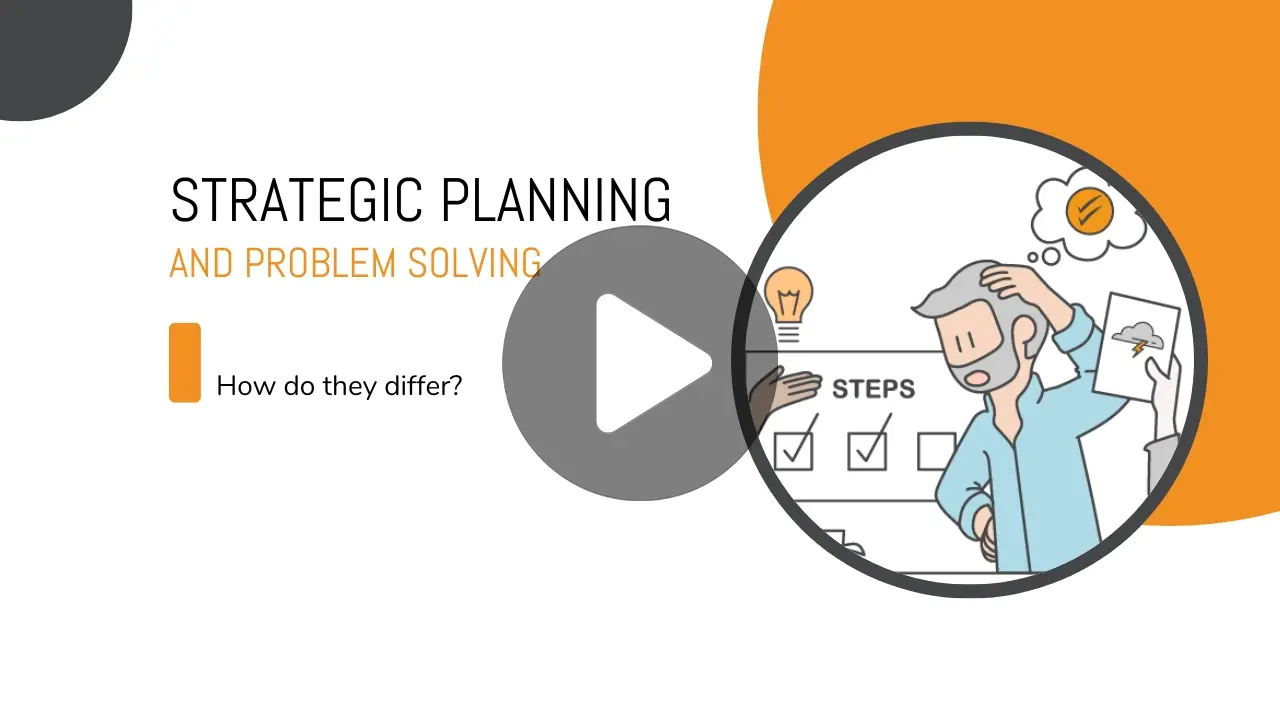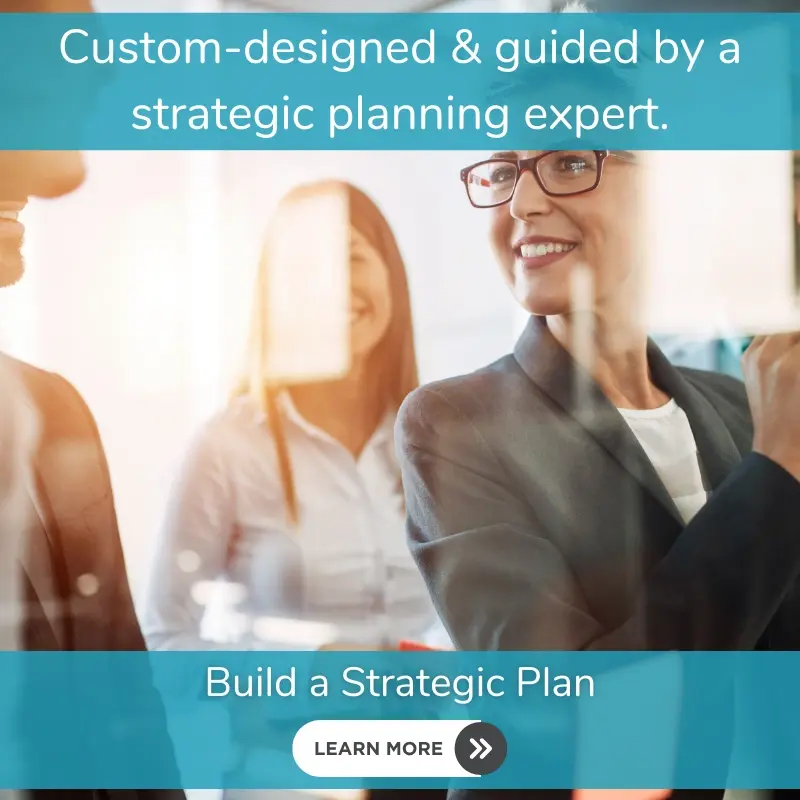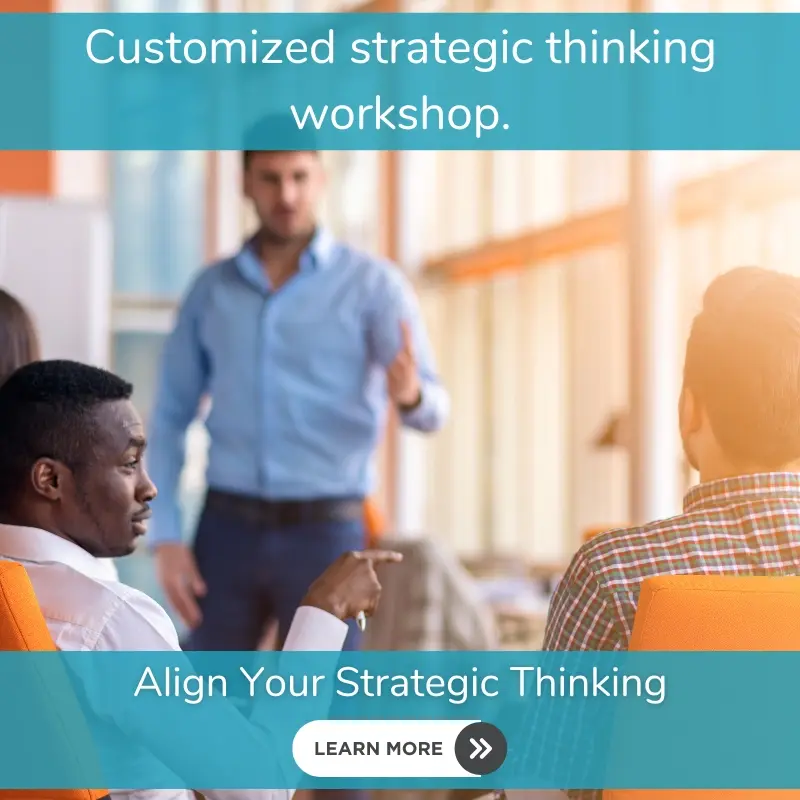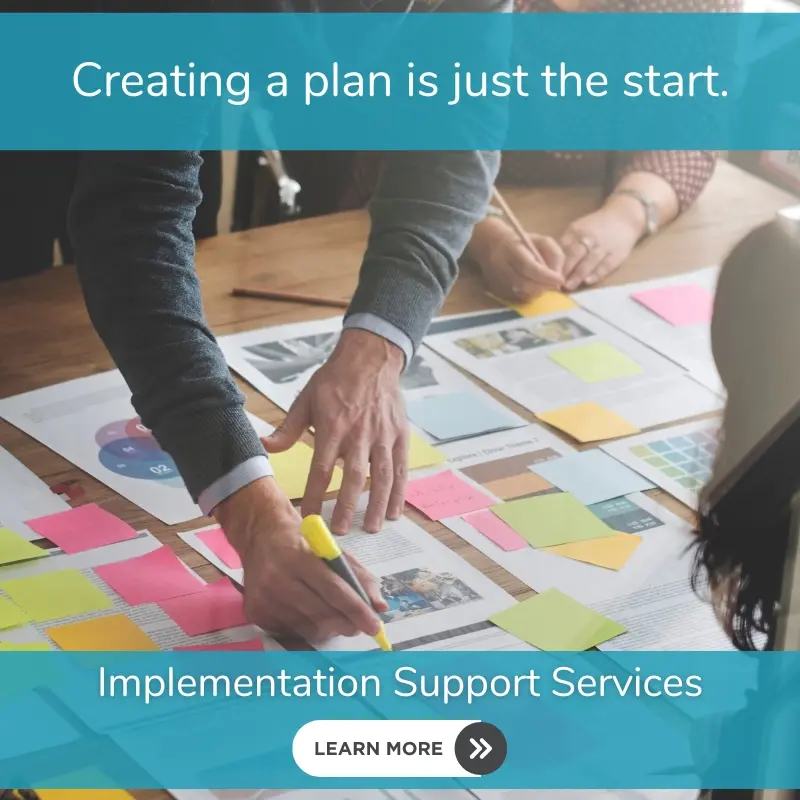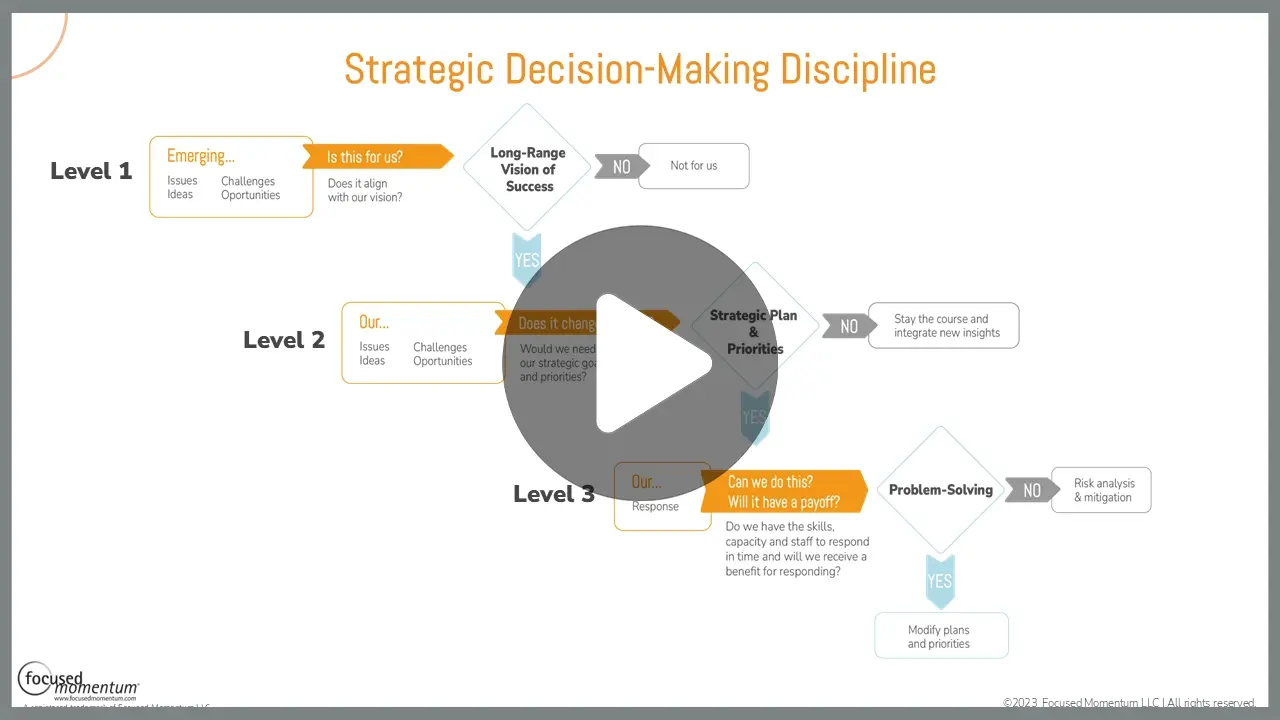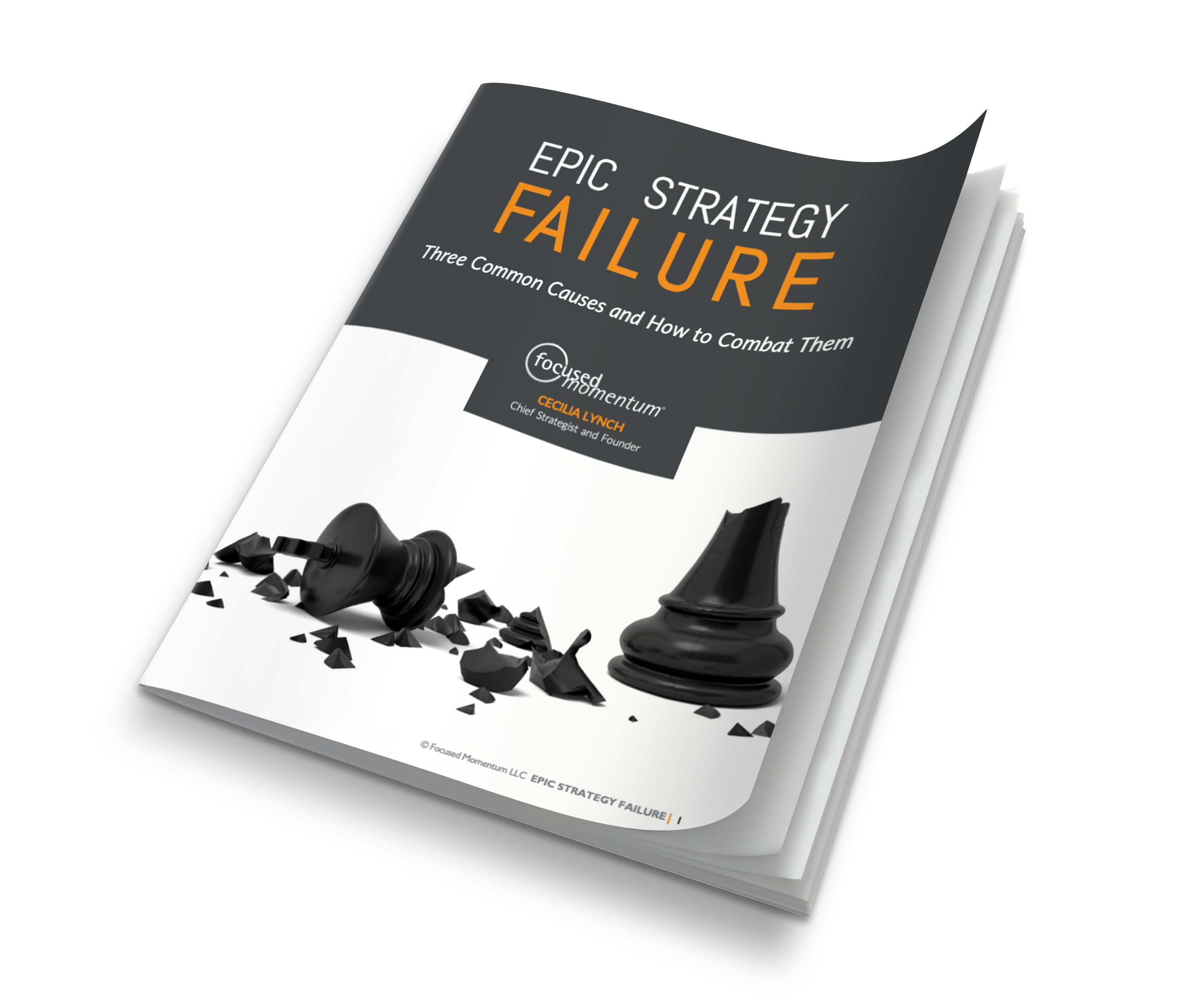Strategic Planning
What is strategic planning, and why do you need it?
The essentials for anyone leading a business or nonprofit, as well as those leading a strategic planning effort.
Download our FREE Guide

Strategic planning is a structured leadership process for defining long-term goals, aligning teams, and making strategic decisions.
This page answers the most common questions about how to build a strategic plan, including its key concepts, steps, and how to ensure your plan succeeds.
If you have a particular question not covered here, please CONTACT US. We will be happy to answer it.
What to Expect from a Strategic Planning Effort?
Step 1: [How to Conduct] the Strategic Assessment
The Strategic Assessment phase clarifies where you are today and gathers the beliefs and perspectives about future success.
At a minimum, this phase involves collecting input from key stakeholder groups, distilling competitive market insights, and deepening the shared understanding of the most recent trends impacting your "market".
Once compiled, the planning group will review and analyze these assessment findings. This analysis, along with an evaluation of your current business model and performance against current goals, creates a shared view of where you are today and documents beliefs about future success.
It should contain:
• A mix of facts, beliefs, insights, and perspectives of your current state
• Questions and critical issues that need to be addressed in your planning effort
• Clues to what might lie ahead from experts, research, or industry/market analysis
In the strategic assessment are clues to your direction, but an assessment is not enough to create a winning strategic plan.
Key components:
• Summary of Perspectives & Insights
• “Market” and competitive landscape analysis
• Insights from performance against current plans and benchmarking performance against your industry if available.
• Stakeholder analysis
• Identification of critical strategic issues

Step 2: [How to] Define a Strategic Vision
A strategic planning process is undertaken to define a long-range plan for future success. In this step, the planning team moves away from what is to create a shared future vision of success - where they ultimately want to be and what impact or metrics will define their view of success.
Your vision defines an ideal destination and should:
• Motivate stakeholders to make it a reality
• Transfer the hero persona to the entire organization
• Provide a clear picture of what it will be like when you arrive
• Be aspirational and challenging, even intimidating to those comfortable with the status quo
• Set the tone for the journey ahead
A powerful vision acts as a call to adventure, inspiring your organization to embark on a transformative journey. It should be exciting and slightly daunting (like the old BHAG vision statements), but it must also clearly define a future business model to drive strategy development.
Key components:
• Long-term perspective (typically 5-10 years)
• Aspirational and inspiring language
• Clear alignment with organizational values
• Consideration of stakeholder aspirations
Step 3: [How to Develop] a Strategic Direction
The final step in strategic planning is to close the gap between the strategic assessment (where you are today) and where you ultimately want to be (your long-range vision of success).
Your strategic direction outlines how you plan to close this gap and transform over time.
Your Strategic Direction should include:
• The path you intend to take - your strategy
• The beliefs about why this is the best way forward - your strategic plan assumptions
• The key milestones that will mark progress - strategic goals during the journey
The Process to develop your strategic direction should:
• Stimulate stakeholders' imagination and garner their commitment to its success
• Activate those working to achieve the strategic direction by providing them with a clear roadmap to move from today to the plan's ultimate end-state - the future vision of success
A strategic direction does not detail every step of this journey. It provides a clear framework for tracking progress and for making decisions on priorities.
Key components:
• High-level strategies aligned with your future business model as defined by your vision
• A set of time-bound, clear, and measurable strategic milestones that tell the story of your desired journey over time.
• Resource needs and allocation plans
• Risk assessment and mitigation strategies
How to Transform Your Strategic Planning?
By adopting a classic storytelling structure, leaders worldwide transform strategic thinking into brilliant strategy that changes the world. You can too!
-
Engage multiple stakeholders
-
Leverage their thinking in your strategy development
-
Unleash creativity and inspiration
-
Define how to make your "hero's journey" a reality
DOWNLOAD our Free eBook
The Components of a Strategic Plan
Although its final form and content are as unique as the entity and its planning process, at a minimum, a strategic plan should include the following components.
You can get a copy of this section by downloading our Free Guide to Strategic Planning.
-
1. Executive Summary
Introduction of the entity: Mission, Vision, and Values
Statement of planning process goal and objectives
High-level overview of the planning process (timeline, key milestones, and participants)
Acknowledgments to those who participated in the planning process.
-
2. Context and Strategic Assessment
A summary of the state of the entity as you began the planning process, including:
- The assets you will invest in and protect as you move ahead
- The favorable forces you can leverage in your future plans
- The challenges you know you need to address in your plan
- The vulnerabilities you will need to watch or research to prepare a response
A summary of your strategy development discussions to guide the reader on how the planning group viewed the following:
- The status of the key drivers of today’s business model.
- A brief analysis of the “market” in which you operate and the critical dynamics of this “market.”
- Is it growing or contracting? What is the rate of growth or decline?
- Innovations, trends, or regulatory changes influencing it.
A summary of performance against shifts, innovations, and trends. Including, but not limited to the following:
- Analysis of competition and your entity’s position within its competitive set.
- Who do you compete against? Remember, even nonprofits compete for funding, donors, and those they strive to serve.
- Your competitive assessment - how you stack up against this competition.
A summary of the key strategic issues/questions to be addressed by this strategic plan.
-
3. Strategic Plan Goals Summary
Inspired and aligned with the Mission and Vision of Success
Future business model – what will your business look like?
- Changes to your Product/Service offering
- Shifts in your partnerships and the role they play in your success
- Shifts in who your competitive set is and how they view you
- Changes to your organization’s core competencies – what you will need to add or strengthen.
The ideal position you want to hold in your “market” – what you or your brand will be known for.
Culture – how your culture will be enhanced or strengthened.
Results - how will you measure success
- High-level KPIs
-
4. Core Strategies
Align with the core elements of your business model.
Summarized for each strategic milestone.
Detail any cross-functional initiatives, including which core strategy area drives each initiative.
Metrics or results for each.
-
5. Strategic Direction Summary
Use the strategic milestones from the core strategies to tell an integrated story of how the organization will progress from now to the vision date.
Include key objectives in plans for each milestone.
-
6. A Financial Forecast
Financial projections, the timing of investments, and return on those investments.
- A high-level financial model with a base year (typically current or immediately prior year) and annual projections through the plan’s time frame.
- Reflecting the implications of your strategic plan on your financial performance over the planning time frame (use dates from the strategic milestones (typically 18 – 24 months apart or each year).
- This model should indicate the amount and timing of investments needed to support each plan element and the expected return on this investment.
-
7. Key Plan Assumptions and Risks
The fundamental assumptions of your plan.
List those things that must happen for your plan to be successful, including additional resources or investments required.
- To be successful, we must…
List all risks identified during the strategy development and, if possible, recommendations to mitigate.
-
8. Commitment/Approval
Clarify what is needed to gain approval and begin implementing the plan.
For example:
- Request for funding
- Board or leadership team approval
- Budget variances
- Agreement to support and work to achieve the plan’s goals.
Want to share what you are learning?
DOWNLOAD our Free eBook
The Components of a Strategic Plan are included in this guide.😉
The Evolution of Strategic Planning
Strategic planning, as we know it today, has roots that stretch back through millennia of human history.
Its evolution reflects the changing nature of human organization, from ancient military campaigns to modern global corporations. Let’s trace this fascinating journey:
Ancient Origins
500 BCE
The Art of War

1920s - 1950s
Early Business Applications

1920s - 1950s
1960s - 1970s
Rise of Corporate Planning

1980s
Competitive Strategy Era

1980s
1990s
Resource-Based View

2000s - present
Agile and Adaptive Strategies

2000s - present
today
The Strategic Planning Model
A Strategic Planning process should stimulate creativity and provide an environment to explore new ideas that will propel the organization forward with renewed excitement and optimism. To accomplish this, planning groups need to interrupt their typical business management patterns to open gaps in their thinking. This “gap” is where groups gain new insights and fresh ideas for strategy development.
The Strategic Planning Model defines the structure to guide the steps a strategic planning process should follow.

By structuring your strategic planning process around these three steps, you will deepen your team’s strategic thinking and leverage your raw materials to a transformative level.
This will, in turn, propel your organization forward to new levels of success, and your team will be prepared for their epic journey.
The power of this approach lies in its narrative structure. It turns strategic planning from a dry, analytical process into an engaging story of transformation and growth.
This narrative approach can help to:
- Engage emotions as well as intellect, increasing buy-in across the organization
- Provide a clear and memorable framework for understanding the strategic plan
- Inspire and motivate team members by casting them as heroes in the organization’s story
- Create a sense of shared purpose and collective mission
By framing your strategic plan as an epic journey, you create a compelling narrative to drive your organization toward its envisioned future.
FAQs and Misconceptions
Strategic Planning has many terms, concepts, and models. Frequently, the terms are similar, and the distinction between concepts and models is subtle.
This section is intended as a resource for definitions and an orientation to many of these elements inherent in strategic planning. It is by no means definitive, but it is based on over 25 years of leading teams through the complexity of strategic planning, so battle-tested.
Check back from time to time, as this section will continue to grow as we find more to share!
What is Strategic Planning?
Strategic Planning is the management process used to create a long-range plan of how to achieve an ideal end-state or a set of goals, often called a vision. This long-range plan is called a Strategic Plan.
What is a Strategic Plan?
A strategic plan is a document that summarizes all the critical strategic thinking from the strategic planning process. It defines where the entity sees itself today and the challenges it is facing. It also describes the ultimate end-state it wants to create (its vision), the high-level path it plans to take to move from where it is today to its vision, and finally, the key near-term priorities to begin this journey.
Strategy Vs Plan?
The word "strategy" is overused today. So, how do you know what you need, a strategy or a plan?
A strategy is the overarching narrative that guides an organization's journey from its current state to a desired future state. It's a high-level story of how you intend to overcome challenges, leverage strengths, and navigate the competitive landscape to achieve long-term objectives. A strategy provides direction and purpose, serving as a compass for decision-making across all levels of an organization.
A plan, on the other hand, is a detailed roadmap that outlines specific actions, timelines, and resources required to achieve a particular goal or objective. It's the tactical component that brings a strategy to life, focusing on the who, how, when, and how much of execution. A plan is typically more short-term and concrete than a strategy, providing a clear path for implementation.
How does a Business Plan differ from a Strategic Plan?
A business plan is a detailed planning document that defines how to achieve a specific milestone or objective for an entity within the strategic planning period. It covers specifics about product/program development, marketing tactics, revenue/growth targets, and the resource requirements to execute these specific plans. It is often used to collaborate with partners or to secure funding for a specific unfunded objective in the plan. It is typically more specific than the strategic plan, and it may omit elements that are not relevant to its audience.
As already stated, a strategic plan charts the course as defined by the plan's strategic goals. It covers a planning period of up to 10 or 15 years and outlines the high-level story to achieve a comprehensive set of goals by the end of this period.
A business plan details the voyage by guiding near-term decisions on priorities and resource allocations, whereas a strategic plan sets out the criteria to make long-term or higher-stakes decisions.
What is Strategy Development?
Strategy development is the exploration of ideas and plans to achieve a long-term goal or set of goals.
It is the process of exploring, building out, and testing various alternatives and options. To many, this non-linear and often iterative process can feel chaotic and unproductive, but it is strategic thinking in action. It is how "crazy" ideas become brilliant plans and how teams deepen their understanding to lead strategy execution.
Are Strategic Planning and Strategy Development the same thing?
They are not the same thing.
Strategic planning produces a strategic plan using strategy development structures and techniques.
Strategy development can take many forms depending on the planning objective.
- Initiative development is a structured approach for building a long-term plan from an idea or priority during strategic planning. This strategy development technique allows teams to evaluate an idea before including it in the strategic plan.
- Strategy integration is a strategy development activity in which a planning group prioritizes many objectives into a single, phased, and staged approach. This integrated approach, marked by specific milestones, forms the strategic plan story over the planning timeframe.
- Scenario planning is the process of developing multiple ideas in parallel and then integrating the highest-ranked options into a single plan. This strategy development process is preferred for highly complex situations with many variables or when conditions are so unpredictable that a change in a variable triggers a shift in plans.
Building a strategic plan is a multifaceted, iterative process. Using many different forms of strategy development during this process fosters strategic thinking that may unveil brilliant new insights to propel an organization to new levels of success.
Problem-solving follows a linear approach.
-
Define and clarify the problem.
-
Generate alternatives to solve the problem.
-
Evaluate the alternatives based on current needs, resources, and payoff.
-
Get into action or complete an action plan.
A problem-solving process is straightforward, well-understood, and generally satisfying.
In contrast, the model for strategic planning forces a disruption in this linear path to create the space for new thinking.
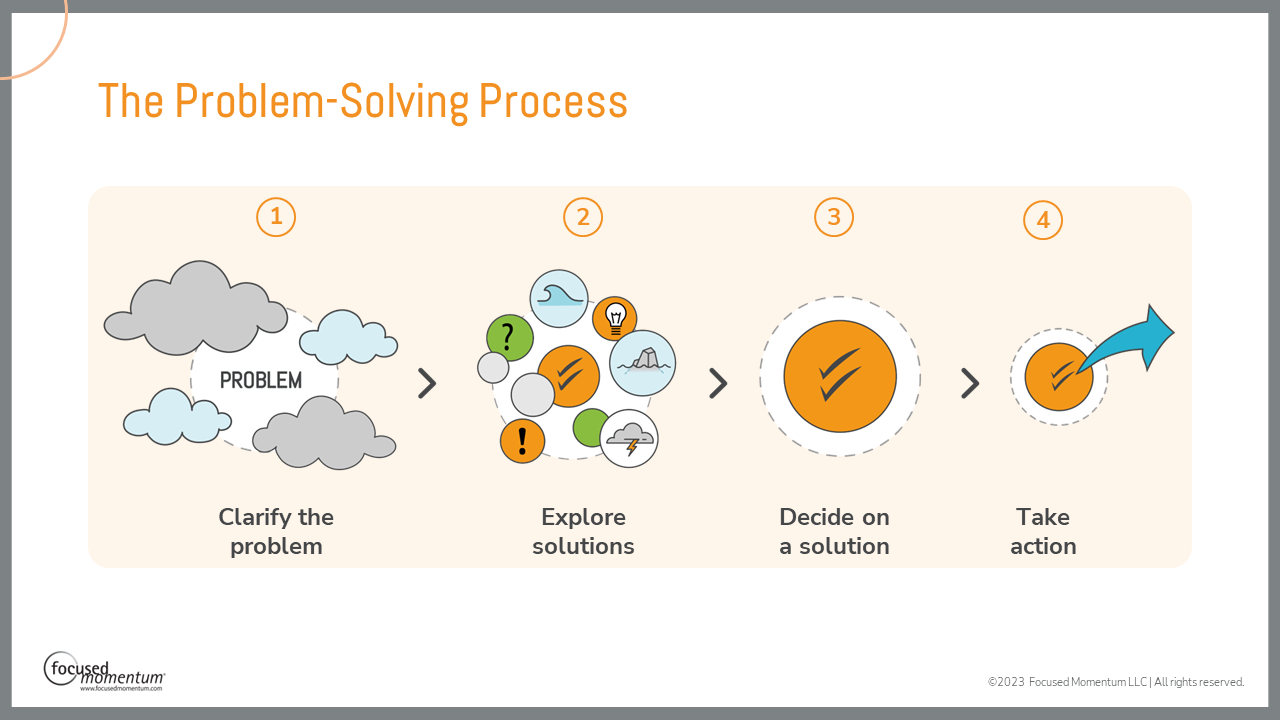
The strategic planning process is structured around three distinct steps:
- Complete a Strategic Assessment.
- Created a values-based Vision of Success.
- Close the gap with the Strategic Plan (goals and plans).
It is designed to disrupt thinking patterns and create gaps in which new insights and fresh thinking are discovered.
This approach fosters new insights and perspectives on how to evaluate key elements of your assessment. Things that seemed crucial during assessment discussions are now viewed through the lens of a shared long-range vision. This perspective - with the end in mind - is essential for strategic thinking.
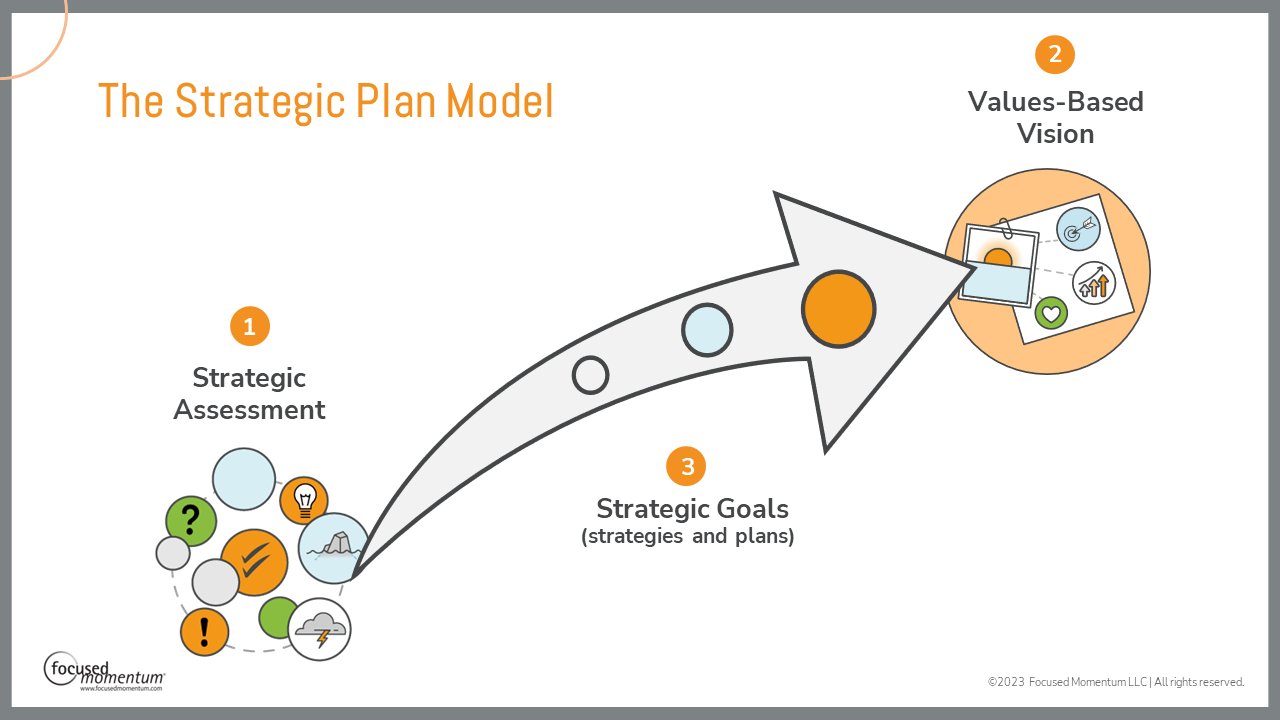
These two distinct management processes are designed to produce different results.

Inexperienced leadership teams often believe strategic planning is just more complex problem-solving. They are unprepared to disrupt their typical process to engaging in strategic thinking. Very quickly their processes become chaotic and they feel overwhelmed.
Choosing the wrong process is often a contributor to the failure of strategic planning processes.
Find out more about our Strategic Planning Services
Strategic Planning Flashcards
A few additional terms for you!
Hover over each card to view the definition
What is a vision?
The ideal end-state you are hoping to achieve. It defines the big “what” you aspire to achieve to realize your ultimate goals. Your vision should describe how you will measure success.
What is a mission?
Your "why": the impact you want to make for those your strive to serve and the unique role you ideally want to play in making this impact. Updated rarely, the language is modified from time to time to align with significant shifts in your business model.
What is a strategic direction?
A comprehensive story of how your organization will evolve over the planning timeline (3-5 years, 5-8 years, 10-15 years) as you strive towards achieving the vision.
What is a strategy?
A strategy is a story. A strategic plan may have an overarching strategy: mission, vision, strategic direction AND each milestone or objective may have its strategy too.
What are strategic milestones?
Thematic goals that, when attained, will mark significant progress in your strategic direction.
Ideally, your strategic plan should include three milestones between the current period and vision, typically 12-24 months apart.
What are strategic objectives?
Specific, measurable targets to achieve an organization’s strategic milestones and overall
vision. These objectives encompass internal and external areas and frequently serve as stepping stones between the current and desired future states.
What are core strategies?
The foundational areas of your business model will be continually strengthened as you progress towards your long-range vision of success.
What is a plan?
A plan is the details: who, how, when, and how much to achieve each goal or objective.
Why Do You Need a Strategic Plan?
A strategic plan is often required for governance or financing. Yet, even if it is not a requirement, a strategic plan is an essential decision-making tool for leadership teams.
By building a strategic plan, a leadership team unifies its understanding of where an entity is going and the best way to get there. It is used to guide planning and management decisions and to efficiently respond to emerging issues between plan cycles without backtracking on your strategic goals.
Using your Strategic Plan to Set Management Priorities
A strategic plan serves as a roadmap for an organization's future, providing a crucial framework for strategic decision-making. A primary function of a strategic plan is to guide strategic decision-making in both short-term operations and long-term goals. The strategic plan provides a solid strategic framework so leaders can:
- Prioritize initiatives and allocate resources effectively
- Align day-to-day activities with overarching strategic objectives
- Identify and address potential obstacles before they become critical issues
- Foster a culture of proactive planning rather than reactive problem-solving
However, most leadership teams lack a way to use their strategic plan in their decision-making.
Using your Strategic Plan to Improve Decision-making
From a proactive perspective, a strategic plan provides the priorities and goals to guide operational plans as well as annual or multi-year resource allocations. It helps to guide management decisions such as:
- Which long-term goals must we include in this year's plans and budgets?
- How do we allocate our resources to their highest and best use to meet current goals and prepare us to take on long-term goals?
- What activities or resources should be eliminated or redeployed to align with long-term goals?
- What new competencies do we need to add to our operations?
From a responsive perspective, a strategic plan provides the criteria to decide on issues, opportunities, ideas, or threats that emerge after the strategic planning process ends. No planning effort can incorporate all future conditions, and in today's highly fluid and dynamic operating environments, leadership teams must embrace the duplicity of being vision-driven and market-responsive.
Without making this dual focus visible to those they lead, leadership teams often are criticized for changing direction or not sticking with their decisions. The answer is a strategic decision-making discipline that uses the organization's strategic plan to make decisions consistently.
What is a Strategic Decision-Making Discipline?
A strategic plan defines a deliberate plan and priorities to achieve long-range goals. It also provides the criteria for applying strategic decision-making discipline as issues, ideas, opportunities, and challenges emerge between planning cycles.

Select an option below:
- Level 1 Questions
- Level 2 Questions
- Level 3 Questions
Strategic Decision-Making Level 1
For any emerging issue, idea, opportunity, or challenge, a leadership team must reflect on its most fundamental strategic question:
- Is this for us?
- Does this align with our mission and vision?
- Or, stated differently, must we be distracted by this, or is this for someone else?
Not every opportunity is your opportunity, not every challenge is one you need to address, and not every new idea is one your organization should pursue.
When leadership teams have a well-defined mission, a shared understanding of what they are ultimately working towards—their vision of success—and authentic core values defined, they can quickly examine emerging issues and confidently decide how to proceed.
If the group consensus is “No, this is not for us.” The leadership team can refocus on adhering to its plan with a clear rationale for why it made its decision.
If the consensus is "yes," it aligns with the mission, vision, and values, the group moves to Level 2 questions.
Strategic Decision-Making Level 3:
When ideas, issues, or opportunities pass levels 1 & 2, teams can use their problem-solving to define how the organization could respond in the near term and what it can expect to see as a return or payoff for this response.
The response looks like any action plan:
- Can we do this (respond), and will it have a payoff?
- What needs to be done, and by when?
- How should we plan to do this?
- Who should lead or be involved in acting on this plan?
- At what cost?
- What are the trade-offs we will make to act on this?
- How quickly do we need to act on this plan?
Strategic Decision-Making Level 2:
For emerging issues that make it through level 1 questions (they align with an organization’s mission and vision, leadership teams must evaluate whether they need to modify their plans to respond and, if so, how.
- Does it change our plans and priorities?
- Should we change our priorities or wait for the next planning cycle?
If the leadership team evaluates that the emerging issue can wait for the next planning cycle, they may assign a team member to gather market intelligence for the next planning cycle. They may also allocate resources to conduct focus groups or primary research to better prepare for integration in a future planning process.
However, if the decision is to address this issue now, a planning group should be formed to address Level 3 questions.
What are the Causes of Strategic Plan Failure?
Strategic planning is arguably one of the most visible and significant undertakings for management. Yet alarmingly, 80-85% of strategic planning efforts are deemed a failure by those who lead them.
In recent years, improvements have been made by focusing on implementation. New software tools have been developed to embed strategic goals into operating plans and provide greater visibility and data that reveal factors that could block progress. These new management tools and practices will continue to support implementation, but what if your planning process produces a weak plan?
As strategic planning consultants with thousands of hours guiding leadership teams through their strategy development and implementation we have fantastic insight into why strategic plans fail. In fact, we are often brought in after management experiences an epic failure in prior planning efforts.
From this vantage point, we have compiled the most common reasons why well-intended efforts can produce such poor results.
Incomplete Strategy Development
It’s not unusual for those leading the strategic planning effort to set the expectation that strategy development can be completed in a one-day planning meeting. Therefore, it is understandable that when participants reach a consensus on a new goal or set of goals, they think they have completed their strategic planning. In reality, they have only begun.
Although it may be exciting and initially inspiring to think that one can make a magical leap into the future in just one day, that’s not how it works. Strategy development takes the patience and the focus of a craftsman.
An excellent planning process aims to leverage the excitement generated during group strategy meetings, when passion is fresh, to agree to a set of fast-paced next steps to complete the planning.
You want to take advantage of the momentum created by the enthusiasm to make the commitment for the hard lift – not just feel good about reaching an agreement and then leave it behind.
A lack of understanding of how to lead such a process significantly contributes to the high failure rates of strategic planning efforts.
Management Neglect
There is no nice way to say this.
Strategic plans fail because senior management neglects to ensure that new strategic thinking is adopted.
When this occurs, it is 100% the fault of senior management, but it is not intentional. It results from a lack of understanding of their role in nurturing the new direction and possibly an unwillingness to participate in the strategy implementation phase.
In recent years, we have seen the success rates for strategic planning improve. This progress results from new software tools that embed strategic goals into operating plans, allowing greater visibility of what may be blocking successful execution.
Many larger companies have also formed dedicated teams or created full-time roles to guide the implementation of cross-functional strategic goals. These new strategic management disciplines are beneficial but cannot translate the core thinking of a new strategic direction when it comes up against the status quo.
Getting beat
Another reason strategic planning efforts can be viewed as a failure is simply that someone else’s strategy performed better than yours.
You got beat. Beaten by competitors, defeated by changing market conditions, or trounced because you focused on the wrong strategic objectives.
Competition is real, and it’s everywhere!
This goes for the non-profit sector as well as the commercial sector, maybe even more!
So, if your strategy fails because you were outgunned by companies with bigger budgets or outmaneuvered by faster or more agile competitors, you can learn from these setbacks. There is no need to beat up yourself or the planning team.
The fix is adjusting your strategy and returning to the game.
However, suppose you were beaten because you failed to acknowledge and incorporate changing market conditions, resulting in a focus on irrelevant goals. In that case, you must look hard at your strategic planning process because it failed you.
Worried about failing before you start?
Study up. Learn the common causes of failure and how to combat them before you launch the next planning cycle.
DOWNLOAD our Free eBook
What outcomes can I expect from strategic planning?
Everyone expects a document they call a Strategic Plan from the planning, preparations, meetings, discussions, and presentations typically included as part of a strategic planning process. Jump to Components of a Strategic Plan for an outline of this document.
However, as a strategic planning consultant with over 25 years of guiding leadership teams through strategic planning, I know participants expect more than just a document and inclusion from their participation in strategic planning.
The Unspoken Expectations of a Strategic Planning Effort
The most widely held but frequently unspoken expectation is to shift how the organization makes decisions. We have covered how to use a strategic plan in management after the plan is complete, but what about meeting participants' expectations while you are building the plan?
Over the years, I have distilled three factors to ensure our clients not only have a well-crafted strategic plan but also have developed the strategic thinking they will require to navigate its implementation.
#1 CLARITY
Clarity is the cornerstone of any effective strategic plan. It provides a shared understanding anond direction for the entire organization.
Here's what clarity entails in the context of strategic planning:
- Current position and future goals: A clear understanding of where your organization stands today and where you aim to be in the future is essential. This involves a comprehensive analysis of your current market position, the assets you will invest in and protect, challenges you must plan to address, vulnerabilities you will watch and mitigate, and favorable forces you can use to propel your success.
- Assumptions and beliefs about success factors: Clarity extends to the underlying assumptions and beliefs that shape your strategic decisions. By explicitly stating and examining these, you can ensure that your strategy is built on a solid foundation.
- Resource allocation and management focus: A clear plan should outline how resources will be allocated and where management should focus their efforts. This helps prioritize initiatives and ensure that everyone is aligned with the organization's strategic direction.
#2 CONFIDENCE
Confidence is both a result of and a catalyst for effective strategic planning. As your team works together to build the plan, their confidence grows, creating a positive feedback loop that enhances the quality of the planning process.
- Team collaboration in plan development: The process of working together to create a strategic plan builds trust and fosters a sense of ownership among team members. This collaborative approach ensures that diverse perspectives are considered and integrated into the final plan.
- Open discussions and passionate debates: Encouraging open dialogue and even passionate debates about potential strategies and alternatives leads to more robust and well-thought-out plans. This process of rigorous examination builds confidence in the chosen direction.
- Decision-making for new directions: With increased confidence, leaders are better equipped to make tough decisions necessary for implementing new strategic directions. This decisiveness is crucial for driving organizational change and growth.
#3 PRODUCTIVITY
The ultimate goal of management efforts is to enhance organizational efficiency and effectiveness. A high level of organizational productivity is enhanced by the clarity and confidence gained during a robust strategic planning process.
- Consistent decision-making: When decisions are made based on a clear strategic framework, leaders are more likely to stay true to their decisions naturally, resulting in increased productivity. Team members can act with certainty, knowing that their actions align with the organization's overall direction.
- Aligned leadership and messaging: When all leaders communicate the same strategic message, it creates a unified front that empowers employees at all levels to act decisively. This alignment minimizes confusion and accelerates implementation.
- Accelerated implementation and performance: With a clear direction and aligned leadership, organizations can implement strategies more quickly and effectively. This often results in performance that exceeds initial expectations set in the strategic plan.
Confidence is both a result of and a catalyst for effective strategic planning. As your team works together to build the plan, their confidence grows, creating a positive feedback loop that enhances the quality of the planning process.
- Team collaboration in plan development: The process of working together to create a strategic plan builds trust and fosters a sense of ownership among team members. This collaborative approach ensures that diverse perspectives are considered and integrated into the final plan.
- Open discussions and passionate debates: Encouraging open dialogue and even passionate debates about potential strategies and alternatives leads to more robust and well-thought-out plans. This process of rigorous examination builds confidence in the chosen direction.
- Decision-making for new directions: With increased confidence, leaders are better equipped to make tough decisions necessary for implementing new strategic directions. This decisiveness is crucial for driving organizational change and growth.
The ultimate goal of management efforts is to enhance organizational efficiency and effectiveness. A high level of organizational productivity is enhanced by the clarity and confidence gained during a robust strategic planning process.
- Consistent decision-making: When decisions are made based on a clear strategic framework, leaders are more likely to stay true to their decisions naturally, resulting in increased productivity. Team members can act with certainty, knowing that their actions align with the organization's overall direction.
- Aligned leadership and messaging: When all leaders communicate the same strategic message, it creates a unified front that empowers employees at all levels to act decisively. This alignment minimizes confusion and accelerates implementation.
- Accelerated implementation and performance: With a clear direction and aligned leadership, organizations can implement strategies more quickly and effectively. This often results in performance that exceeds initial expectations set in the strategic plan.
Tips for a Successful Strategic Planning Project
Completing a strategic planning effort is a significant effort. To increase its success, we have included a list of the most important factors to clarify before starting.
Set Project Goals & Define Ideal Outcomes
Before scheduling the first planning meeting, clarify the goals for the strategic planning process.
- What significant outcomes do you need from a strategic planning effort?
- What cultural outcomes would you like to see from this planning effort?
Set a Realistic Deadline
Clarify when the plan needs to be completed or approved, then work backward to ensure you can meet this deadline.
If you don't have enough time to complete a comprehensive strategic plan, explore alternative approaches in the short term - see our Strategy Boost™. Then, schedule a full strategic planning process after you have met your near-term deadline.
Optimize the Project Timing
Planning never happens in a vacuum. Being thoughtful about all the other demands on participants is an essential requirement for a successful project.
- What is the best time to schedule the steps in the strategic planning process, considering these other priorities?
Don't Underestimate the Costs
Engaging in strategic planning will have expenses, even if you conduct it entirely in-house. You should prepare a budget for the following:
- Meeting location costs (rooms, catering, AV)
- Travel to bring participants to the meetings
- Supplies
- Consulting fees if you decide to bring in experts.
Include the Price of Participation
One thing that is not a budget line but can be equally important is the time and attention of those asked to participate in planning activities.
The time for things like assessment activities, strategy meetings, strategy development sub-teams, senior leadership sponsorship, participation, preparing to participate, plan modeling, and forecasting. The focus on these activities means that participants cannot be doing something else. That is the price of their participation.
Carefully consider how best to use participants' time to keep the price of their involvement low.
Find the Right Project Sponsors
The process should be sponsored by the most senior individual in the organization but supported by a small team to ensure diversity of opinion on who is involved and how the process is conducted.
For participants to engage effectively, the strategic planning project must be visibly viewed as a high priority from the top.
Be Strategic About How to Increase Participation
As already stated, participation has a price, but everyone typically wants to be involved in strategic planning because it sets a future direction for the organization. Inclusion is essential, but it is not a one-size-fits-all approach.
Outline the strategic planning activities and then determine the best way to ensure inclusion and diversity of viewpoints for each activity. Leverage regular communication to include those who cannot participate in all planning activities.
Plan Communication from Day One
Strategic Planning is an org-wide project; therefore, it should be something everyone knows about. The subtlety comes in what to communicate to each audience group. Before you start, clarify who will update which audience groups and when during your planning process.
Since strategy development is an iterative process and decisions are not made until the plan is complete and approved by the appropriate governance body, there are typically very few details that can be shared. The rule is: when you cannot share details of the planning discussion, share details of the process: tone of meetings, who participated, how preparation activities (that the audience group may have participated in) shaped discussions, and next steps.
Getting your project requirements worked out before you begin will enhance the success of this important and highly visible management effort.



